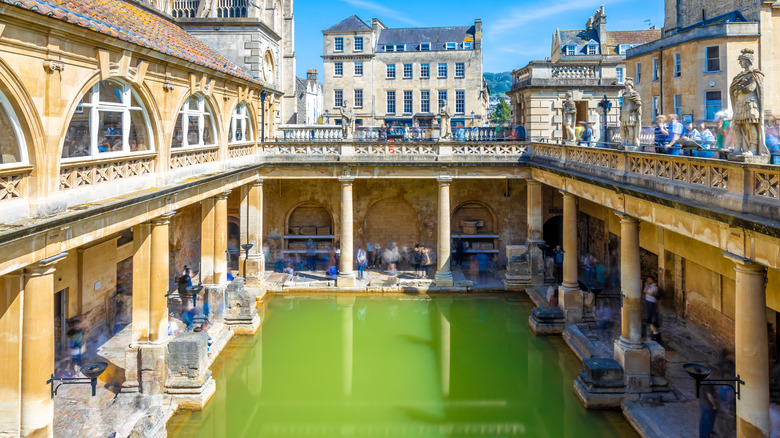In Bath, England, The Mineral Spa Water Is Not Just For Soaking In
Water is everywhere in Bath, England. Nestled comfortably in Somerset County, Bath is an appropriately named city specifically because of the fact that it rests upon three thermal springs: King's, Hetling, and Cross. First discovered by an ancient prince in 863 B.C., the hot mineral water produced by these springs has been the hallmark of the city ever since. The later Roman Baths and Georgian architecture have granted the city as a UNESCO World Heritage Site. However, apart from merely bathing, the mineral-rich waters of Bath have a longstanding tradition of being drunk for health purposes.
Mineral water does not go through any kind of chemical clarification or filtration process. Generally considered more nutritional than standard drinking water, mineral water, as its name suggests, is filled with minerals like magnesium, calcium, and sodium. Consumption of mineral water has the potential benefits of strengthening bones, lowering blood pressure, and regulating circulation, per Healthline.
These, however, were far from some of the ailments Bath's waters were said to be curative of. While it's never actually been proven whether or not the waters actually did cure the ailments in question, the aura surrounding them certainly helped put the city on the map as a spa destination — a status it maintains to this day.
Drinking the Bath water
The three springs are fed by rainfall from the nearby Mendip Hills as well as that absorbed through the limestone bedrock found just north of the city. The mineralized rainwater finds its way to the springs beneath Bath, where it is heated to a very comfortable 115 degrees Fahrenheit — a unique feature for the United Kingdom. Though the springs were discovered several centuries earlier, the Romans built the first proper bathhouse, fed by King's Spring to this day, sometime during the first century. It became incredibly popular with visitors for its reported healing properties.
Though it may have happened earlier, the spring water was not consumed with any kind of reported regularity until at least the 17th century. Visitors would down pint after pint of the hot spring water, fighting through the more sulfuric notes. Apparently, the more than 43 minerals found in the water were said to ease the effects of lead poisoning, as well as cure a series of wide-ranging ailments such as infertility, migraine, sciatica, worms, excess phlegm, and muscle cramps.
Today, Bath's waters are considered beneficial more for hydrotherapy than consumption. However, the water is still available to drink for anyone keen to take on the waters in the modern era. You can buy it bottled, or you can head down to Bath's most famous social club and sample some from the famous fountain at The Pump Room.
It all started at The Pump Room
The Pump Room is a grand, Georgian-style social club that was built in the late 1700s. It exemplifies the upper-class tastes of the time, as well as the popularity of drinking the Bath water, as it were. Fitting to its name, The Pump Room was originally set up as an actual pump room. Water from King's Spring was pumped to the magnificently ornate fountain, where visitors could fill pint glasses with mineral water and consume it for their health. It soon became a hit destination for several renowned socialites of the period, including Jane Austen. The author lived in Bath for a time and was a frequent patron who went so far as to include The Pump Room as a setting in two of her novels.
Today, The Pump Room maintains its social prowess. However, it is more a gathering place for afternoon tea than it is for drinking pints of hot, sulfuric mineral water. Still, the reputation of the club cannot be denied in helping Bath attain its status as a great European spa town.
Even if you're not particularly keen on drinking the unusual-tasting spring water (or have some doubt about the actual health benefits of doing so), Bath is still worth a visit purely for the enjoyment of a good soak. That said, if you're curious, the Pump Room still offers glasses from the fountain for imbibing.


